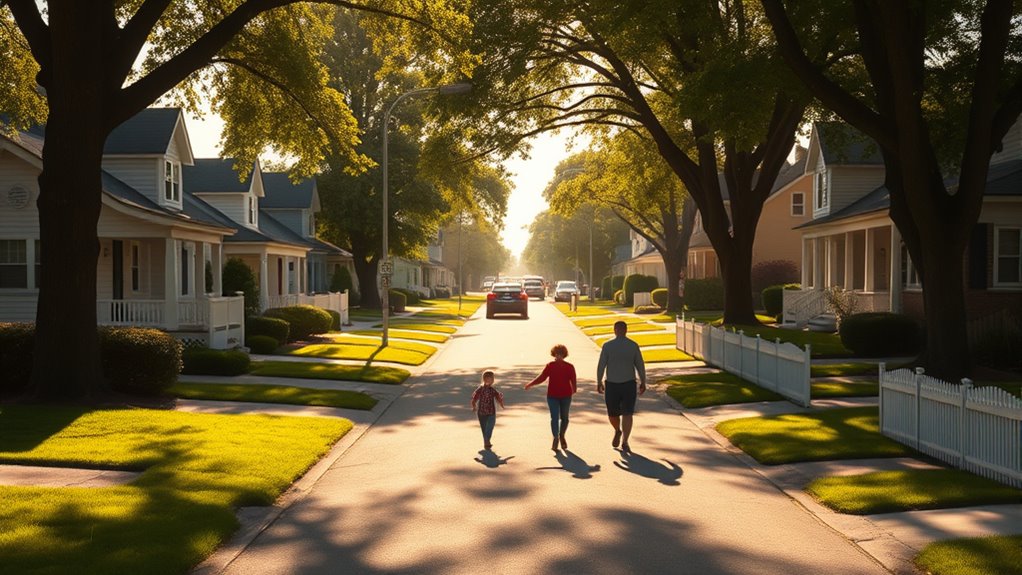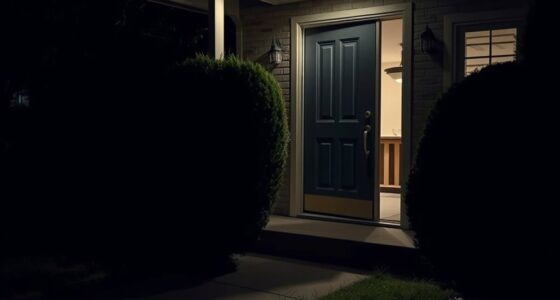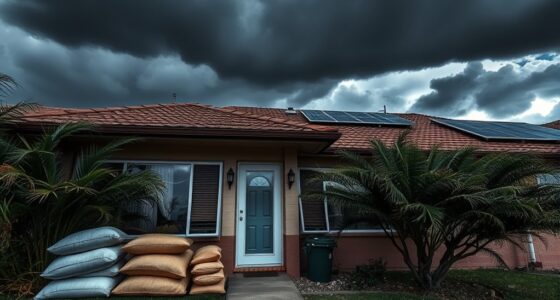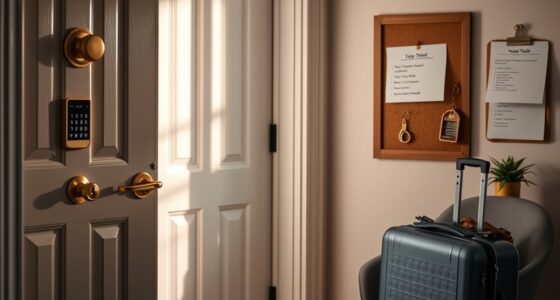Crime statistics may seem to show that suburbs are safe, but they can be misleading. Factors like reporting biases, police funding, and neighborhood design skew the data, making some areas appear safer than they truly are. Socioeconomic issues and community engagement also influence actual safety. Understanding these hidden factors helps you see beyond the surface. To uncover the real picture and make informed choices, it’s important to look at more than just crime rates.
Key Takeaways
- Crime statistics can be skewed by urban design, reporting biases, and law enforcement funding, making suburbs appear safer than they are.
- Underreporting of minor or marginalized community crimes can lead to a false sense of security in suburban areas.
- Media focus on violent incidents inflates perceived danger, while property crimes often go unnoticed or unreported.
- Socioeconomic disparities and limited community resources can increase hidden risks despite low official crime rates.
- Relying solely on crime data ignores community cohesion, neighborhood vibe, and other factors influencing true safety.
Understanding Crime Statistics and Their Limitations
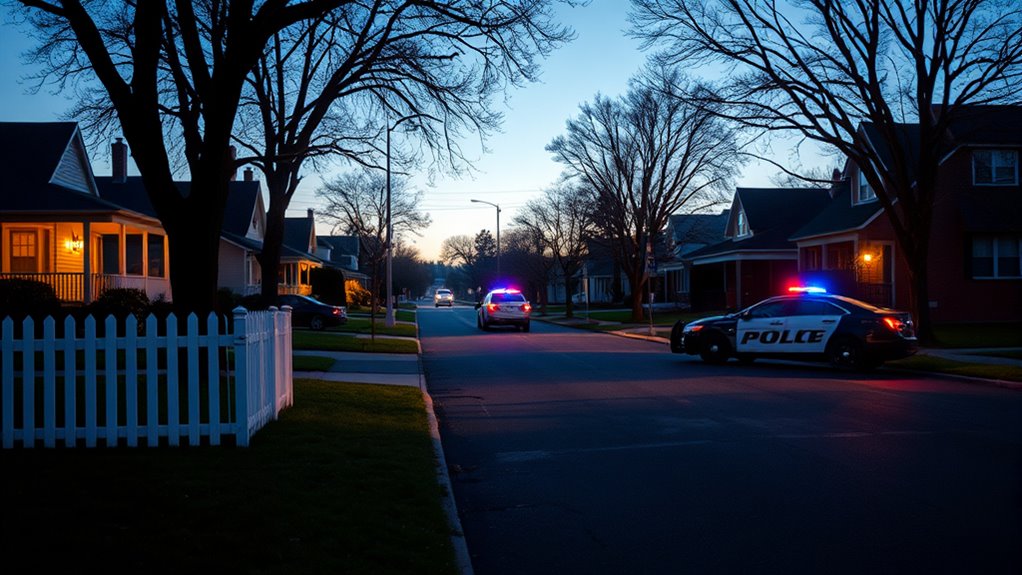
While crime statistics can seem like clear indicators of safety, they often hide important limitations. For example, urban planning plays a role in crime rates; well-lit streets, open spaces, and community centers can deter criminal activity, but such factors aren’t always reflected in official stats. Additionally, police funding influences how thoroughly crimes are recorded and reported. Areas with higher police presence might show more crime simply because officers are more vigilant and data collection is better. Conversely, underfunded neighborhoods may appear safer because crimes go unreported or unnoticed. It’s essential to look beyond raw numbers and consider these factors, recognizing that crime statistics are shaped by policies, resource allocation, and planning — not just actual safety levels. Furthermore, the way data is collected and the effectiveness of law enforcement can be impacted by the use of crime statistics, which may not always accurately represent the true safety of a community.
The Hidden Risks in Suburban Neighborhoods

Many people assume suburban neighborhoods are inherently safer than urban areas, but this perception can be misleading. Urban sprawl often spreads communities over vast areas, making it harder to monitor and respond to emergencies quickly. This dispersed layout can hide risks like traffic accidents, property crimes, or even environmental hazards. Additionally, school quality varies widely in suburbs, affecting your children’s education and safety. Lower-performing schools might lack resources for proper security or extracurricular activities that foster community engagement. You might feel protected by the quiet streets, but these hidden risks mean suburban neighborhoods aren’t immune to dangers. Being aware of these factors helps you understand that safety isn’t just about crime rates but also about the broader environment and infrastructure that influence daily life. For example, bedroom layouts and neighborhood design can impact how effectively residents can respond to emergencies.
Factors Influencing Crime Beyond Location
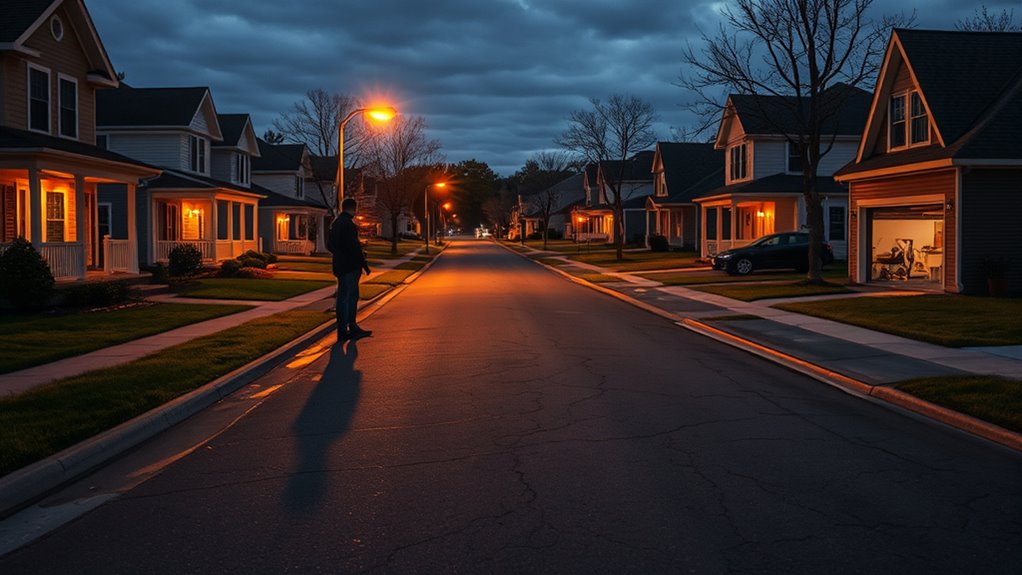
Your neighborhood’s crime rate isn’t just about location; socioeconomic factors play a big role. When communities have limited resources or high unemployment, crime often rises. Additionally, the level of community engagement can influence safety, regardless of where you live. Studies show that high-quality home security can also help deter criminal activity in various neighborhoods.
Socioeconomic Factors Impact
Socioeconomic factors substantially influence crime rates, often outweighing the impact of neighborhood location alone. When economic disparities are wide, residents may experience heightened stress, frustration, and alienation, which can increase the likelihood of criminal behavior. Areas with stark income gaps often lack social cohesion, weakening community bonds and informal social controls that deter crime. Without strong social networks, residents may feel less connected and less inclined to cooperate with law enforcement or support neighborhood safety initiatives. These socioeconomic challenges create environments where crime can flourish, regardless of the physical safety features or perceived affluence of a suburb. Recognizing the role of economic disparities and social cohesion is essential in understanding the true drivers behind crime rates, beyond just geographic factors. Additionally, fostering community engagement can help bridge gaps and promote collective efforts to improve safety.
Community Engagement Levels
How much does community engagement influence crime rates beyond just where a neighborhood is located? It plays an essential role in shaping neighborhood cohesion and encouraging resident participation. When residents actively participate in neighborhood watch programs, social events, or local meetings, they foster a sense of collective responsibility. This increased engagement can deter criminal activity by making neighborhoods less attractive to offenders. Consider these three points:
- Strong community ties reduce opportunities for crime.
- Resident participation increases surveillance and accountability.
- High neighborhood cohesion boosts trust and quick responses to issues.
- Community cohesion can be strengthened through regular communication and shared goals among residents.
Your involvement creates a safer environment, proving that community engagement levels are just as important as location when assessing safety. Active residents transform neighborhoods into resilient, vigilant spaces that discourage criminal behavior.
Comparing Crime Types: Property vs. Violent Crimes
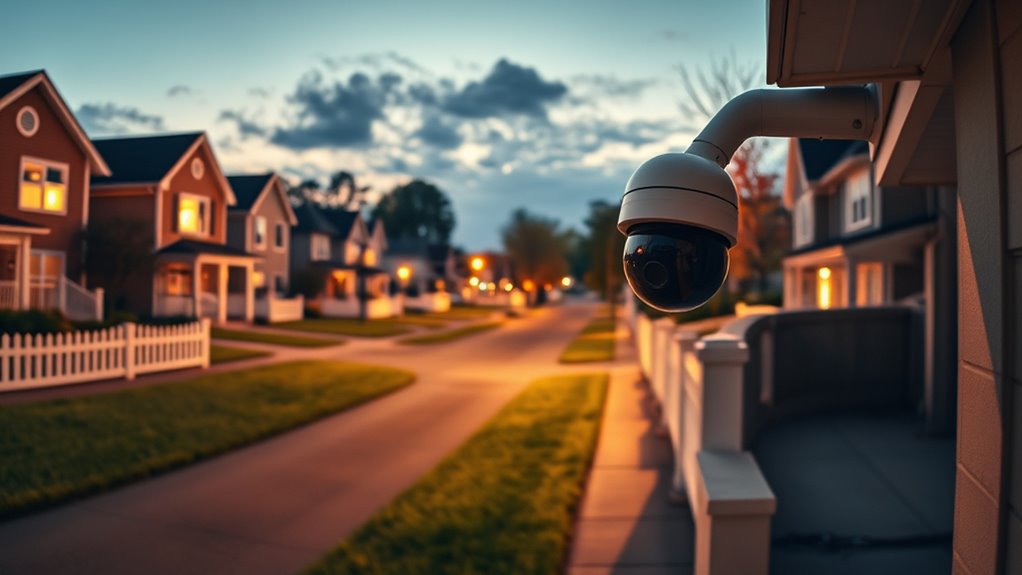
You might think that all crimes are equally dangerous, but property and violent crimes differ considerably in impact. Property crimes can cause financial loss and emotional distress, while violent crimes pose immediate physical risks. Understanding these differences reveals how crime rates can vary widely between suburbs, challenging the idea of truly safe neighborhoods. For instance, the safety of electric heated mattress pads demonstrates that safety features and proper use can significantly reduce risks, much like how understanding crime types can influence perceptions of neighborhood safety.
Property Crime Impact
While property crimes often dominate the headlines in suburban areas, their impact is frequently misunderstood when compared to violent crimes. Property crimes can quietly erode the fabric of urban development and reduce property value over time. Here are three key points to contemplate:
- Property thefts and vandalism can discourage new residents, hindering community growth.
- Frequent burglaries create a sense of insecurity, affecting local business investments.
- Declining property values can lead to economic stagnation, making suburbs less attractive.
- Regular maintenance and security measures, such as appliance testing and safety, can help mitigate some risks associated with property crimes.
Even though property crimes may seem less severe than violent acts, their cumulative effect can undermine the stability and appeal of suburban neighborhoods. Recognizing their true impact is essential for understanding the full scope of crime’s influence on community well-being.
Violent Crime Risks
Although property crimes can cause ongoing economic and community decline, violent crimes pose a more immediate and visible threat to your safety. When violent incidents occur, they often threaten neighborhood aesthetics by creating fear and disorder, making residents hesitant to enjoy public spaces. Such crimes can also impact school quality, as parents may worry about safety, leading to decreased attendance or relocations. Unlike property crimes, which might be isolated or less disruptive, violent offenses directly threaten lives and foster a sense of insecurity. This heightened danger can erode community trust and cohesion, making suburbs feel less safe overall. So, even if property crimes seem more frequent, violent crimes demand your attention for their direct impact on safety and community well-being.
Crime Rate Discrepancies
Crime statistics often show that property crimes occur more frequently than violent crimes in suburban areas. However, focusing only on property crime rates can be misleading. Consider these key points:
- Urban development often attracts thieves targeting valuable goods, skewing property crime stats.
- School quality influences neighborhood stability; areas with better schools may see different crime patterns.
- Violent crimes might be underreported or less visible but can be just as damaging, especially when urban development attracts transient populations.
The Impact of Socioeconomic Variables on Crime Rates
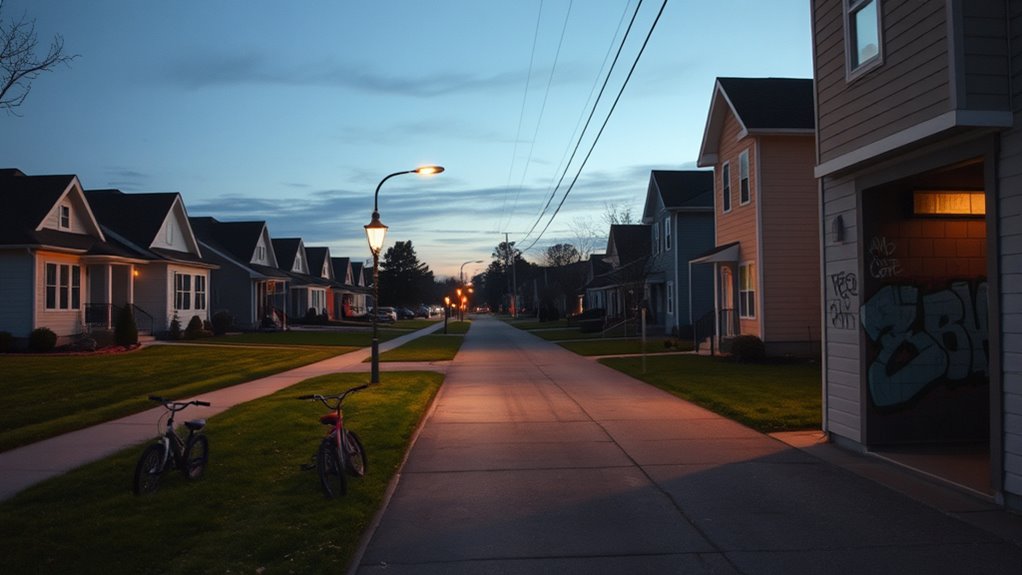
Socioeconomic variables play a crucial role in shaping crime rates across different communities. Economic disparities often create environments where frustration and desperation grow, increasing the likelihood of criminal activity. When income gaps are wide, social cohesion weakens, making it harder for residents to work together and support each other. Areas with limited access to quality education, jobs, and resources tend to experience higher crime rates, not because of the neighborhoods themselves, but due to underlying socioeconomic stresses. These factors influence behavior and opportunities, highlighting that crime isn’t solely about individual choices. Instead, it’s deeply connected to broader societal conditions. Recognizing this helps you understand that addressing economic disparities and fostering social cohesion are essential steps in reducing crime, regardless of a neighborhood’s perceived safety.
How Reporting Practices Skew Perceptions of Safety
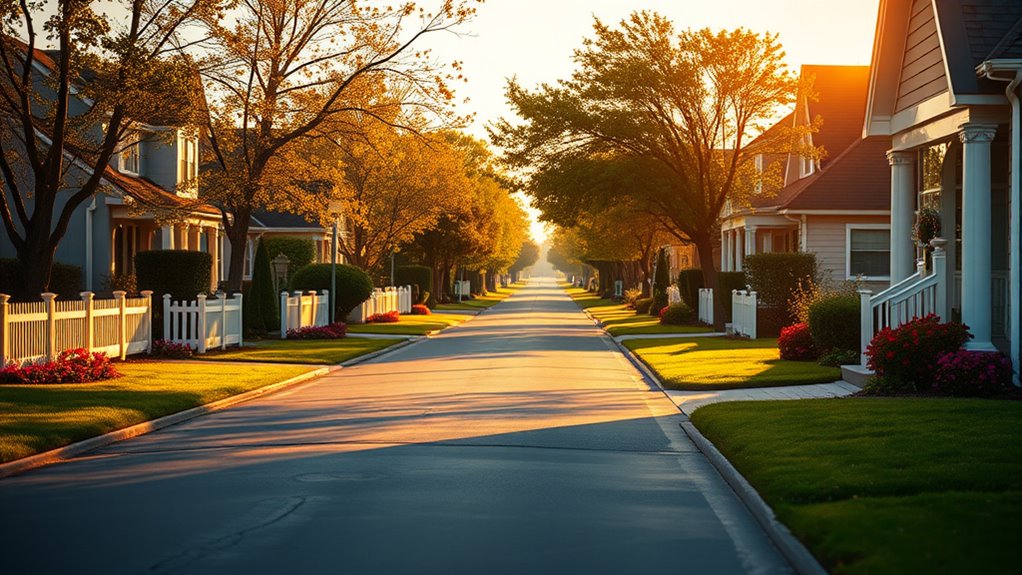
Reporting practices markedly influence how safe a community appears, often shaping public perception more than actual crime levels. Reporting biases and media influence play a significant role in this distortion. Here are three ways these factors skew perceptions:
Reporting practices shape perceptions of safety more than actual crime rates.
- Selective Reporting: Media tends to highlight violent crimes, making communities seem more dangerous than they are.
- Crime Underreporting: Minor offenses or crimes in marginalized neighborhoods often go unreported, creating an incomplete safety picture.
- Sensationalism: Dramatic coverage amplifies fear, leading residents to overestimate risks despite low real crime rates.
These reporting biases distort reality, leading people to believe their suburbs are less safe than they truly are. Recognizing media influence helps you understand that perceptions are often shaped more by reporting practices than actual crime data.
The Role of Community Engagement in Crime Prevention
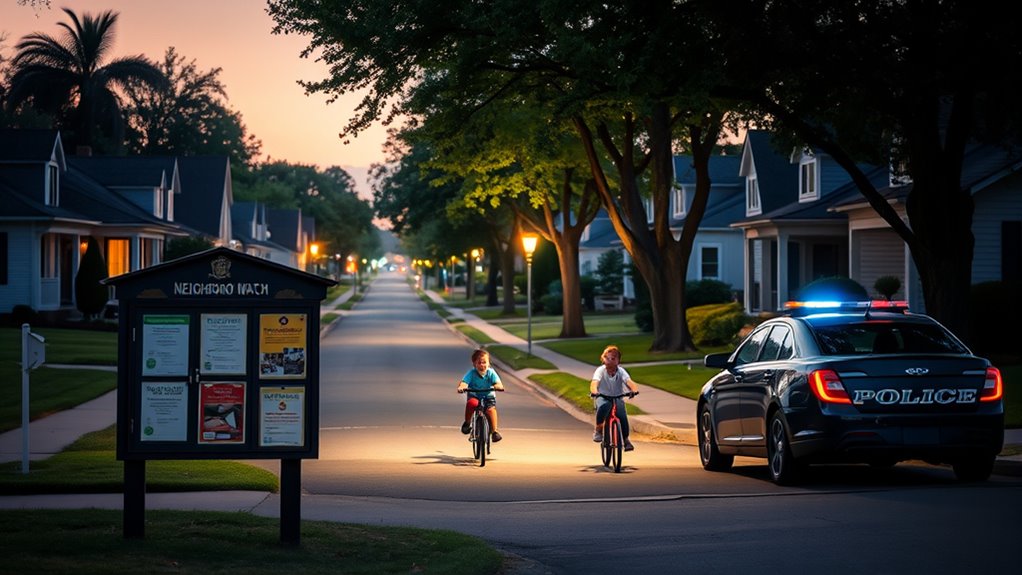
Community engagement plays a essential role in preventing crime by fostering strong neighborhood connections and encouraging residents to take an active role in safety efforts. When you participate in neighborhood watch programs or local community initiatives, you help create a sense of vigilance and trust that deters offenders. These programs promote cooperation among residents and law enforcement, making crime less appealing. Building relationships with neighbors increases the likelihood of sharing crucial information and responding quickly to suspicious activity. You can also organize community events or safety workshops to raise awareness.
| Strategy | Benefits | Examples |
|---|---|---|
| Neighborhood watch | Deters crime, builds trust | Patrol groups, reporting |
| Community programs | Educates and unites residents | Safety seminars, cleanups |
| Regular meetings | Strengthens communication | Block parties, forums |
| Youth engagement | Prevents juvenile crime | Sports, mentoring |
| Volunteer patrols | Adds extra security | Patrols during evenings |
Making Informed Decisions Beyond Crime Data
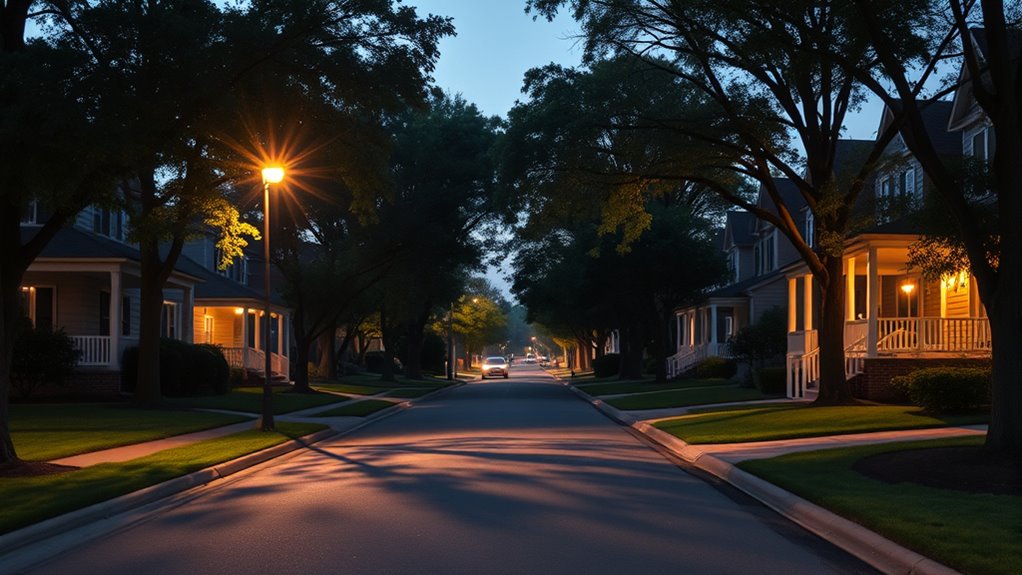
While community engagement helps create a safer environment, making informed decisions about safety requires looking beyond crime statistics alone. Your real estate choices and lifestyle preferences matter just as much. Consider these factors:
- Neighborhood Vibe: Visit at different times to gauge the atmosphere and community friendliness.
- Local Amenities: Check schools, parks, healthcare, and public transportation to fit your lifestyle needs.
- Long-Term Trends: Research housing market stability and growth prospects, not just current crime rates.
- Essential Oils for Well-Being: Incorporate aromatherapy practices to support your overall health and resilience in any community.
Frequently Asked Questions
How Do Police Practices Influence Reported Crime Statistics?
You should know that police practices considerably influence reported crime statistics. When police increase community engagement, they often build trust, encouraging residents to report crimes more accurately. Adequate police funding allows for better resources and staffing, leading to more thorough investigations and higher crime reporting. Conversely, limited funding or poor engagement can result in underreporting, making crime rates appear lower than they truly are.
Can Media Coverage Distort Public Perceptions of Suburban Safety?
Media sensationalism often amplifies stories, making suburbs seem riskier than they really are. You might believe neighborhood stereotypes, thinking certain areas are unsafe based on limited coverage. This distorts your perception of suburban safety, leading you to overlook the actual crime rates and community strengths. By relying on sensational headlines, you may wrongly assume that all suburbs are hazardous, when in reality, many are quite secure.
What Role Does Local Governance Play in Crime Prevention?
Local governance plays a vital role in crime prevention through effective urban planning and promoting community engagement. When you actively involve residents in safety initiatives, it fosters trust and collaboration. Good urban planning, like improved lighting and neighborhood design, deters crime. As a resident, you benefit from local policies that prioritize safety, creating a more secure environment. Your local government’s focus on these areas directly impacts overall community safety.
How Do Demographic Shifts Impact Neighborhood Crime Rates?
Imagine your neighborhood as a living mosaic, constantly changing with demographic shifts. These shifts influence neighborhood composition, affecting social cohesion and economic stability, which can either deter or invite crime. As populations evolve, so do the needs and vulnerabilities of the community. You might notice increased crime in areas undergoing rapid demographic change, highlighting how shifts in who lives there can profoundly impact crime rates and community safety.
Are There Hidden Economic Factors Affecting Crime Trends in Suburbs?
You might not realize that hidden economic factors influence crime trends in suburbs. Economic disparities can create pockets of poverty, increasing crime risks despite overall safety. Limited community investment means fewer resources for youth programs, policing, and social services, which can exacerbate issues. By addressing these economic disparities and boosting community investment, you can help reduce crime and foster safer, more equitable neighborhoods, even if the crime rates seem low.
Conclusion
Remember, crime statistics are like shadows—they can distort the true shape of safety. Just because a suburb appears “safe” doesn’t mean risks aren’t lurking around the corner. By digging deeper and considering all factors, you can see through the illusion of security. Don’t let the surface fool you; instead, explore the full landscape of community well-being. Safety isn’t a destination, but a journey of awareness and informed choices.
